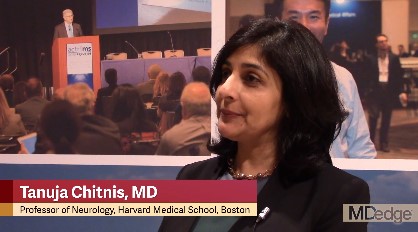User login
CSF biomarker clusters correlate with MS severity
DALLAS – Patients with multiple sclerosis (MS) have elevated levels of specific clusters of cerebrospinal fluid (CSF) biomarkers related to astrocytes and microglia that correlated with disease severity in a blinded analysis of more than 1,000 proteins from the CSF of more than 400 patients with neuroimmunologic disease and healthy volunteers.
Previous studies have indicated that aberrant activation of astrocytes and microglia underlies disability progression in older patients with MS, but researchers have lacked biomarkers of these processes in living subjects. In a presentation at a meeting held by the Americas Committee for Treatment and Research in Multiple Sclerosis, Ruturaj R. Masvekar, PhD, described developing biomarkers of CNS cell–specific processes and examining how they relate to MS disability progression. Dr. Masvekar, a researcher at the National Institute of Allergy and Infectious Diseases, and his coinvestigators used a modified DNA aptamer assay to measure proteins in the CSF of 431 patients with neuroimmunologic diseases and healthy volunteers, followed by variable cluster analysis and in vitro modeling to define 64 clusters of CSF biomarkers that relate to CNS cell types.
The study included 42 healthy donors, 20 patients with clinically isolated syndrome, 57 patients with noninflammatory neurologic disorders, 127 patients with relapsing-remitting MS, 72 patients with secondary progressive MS, and 113 patients with primary progressive MS. In a training cohort of 217 participants, the researchers assessed how biomarkers differed between the diagnostic categories. The researchers then validated the results in an independent cohort of 214 participants.
One astrocyte-related cluster (MMP7, SERPINA3, GZMA, and CLIC1) and one microglia-related cluster (DSG2 and TNFRSF25) was significantly elevated in all MS subgroups, compared with healthy controls and patients with noninflammatory neurologic disorders.
In addition, these clusters “significantly correlated with clinical measures of disability, CNS tissue destruction, and MS severity,” Dr. Masvekar said.
The microglial cluster was significantly elevated in all MS subgroups, whereas neuronal endothelial, astrocytic, and oligodendroglial biomarker clusters were elevated only in patients with progressive MS.
“Microglial activation is present in all stages of MS, while toxic astrogliosis increases with MS duration, concomitantly with neuronal and oligodendroglial degeneration,” Dr. Masvekar said. “Microglial activation and toxic astrogliosis likely partake in CNS tissue destruction and enhance MS severity.”
This study, which was recently published in Multiple Sclerosis and Related Disorders (2019 Feb;28:34-43), was supported by the intramural research program at NIAID.
SOURCE: Masvekar RR et al. ACTRIMS Forum 2019, Abstract 281.
DALLAS – Patients with multiple sclerosis (MS) have elevated levels of specific clusters of cerebrospinal fluid (CSF) biomarkers related to astrocytes and microglia that correlated with disease severity in a blinded analysis of more than 1,000 proteins from the CSF of more than 400 patients with neuroimmunologic disease and healthy volunteers.
Previous studies have indicated that aberrant activation of astrocytes and microglia underlies disability progression in older patients with MS, but researchers have lacked biomarkers of these processes in living subjects. In a presentation at a meeting held by the Americas Committee for Treatment and Research in Multiple Sclerosis, Ruturaj R. Masvekar, PhD, described developing biomarkers of CNS cell–specific processes and examining how they relate to MS disability progression. Dr. Masvekar, a researcher at the National Institute of Allergy and Infectious Diseases, and his coinvestigators used a modified DNA aptamer assay to measure proteins in the CSF of 431 patients with neuroimmunologic diseases and healthy volunteers, followed by variable cluster analysis and in vitro modeling to define 64 clusters of CSF biomarkers that relate to CNS cell types.
The study included 42 healthy donors, 20 patients with clinically isolated syndrome, 57 patients with noninflammatory neurologic disorders, 127 patients with relapsing-remitting MS, 72 patients with secondary progressive MS, and 113 patients with primary progressive MS. In a training cohort of 217 participants, the researchers assessed how biomarkers differed between the diagnostic categories. The researchers then validated the results in an independent cohort of 214 participants.
One astrocyte-related cluster (MMP7, SERPINA3, GZMA, and CLIC1) and one microglia-related cluster (DSG2 and TNFRSF25) was significantly elevated in all MS subgroups, compared with healthy controls and patients with noninflammatory neurologic disorders.
In addition, these clusters “significantly correlated with clinical measures of disability, CNS tissue destruction, and MS severity,” Dr. Masvekar said.
The microglial cluster was significantly elevated in all MS subgroups, whereas neuronal endothelial, astrocytic, and oligodendroglial biomarker clusters were elevated only in patients with progressive MS.
“Microglial activation is present in all stages of MS, while toxic astrogliosis increases with MS duration, concomitantly with neuronal and oligodendroglial degeneration,” Dr. Masvekar said. “Microglial activation and toxic astrogliosis likely partake in CNS tissue destruction and enhance MS severity.”
This study, which was recently published in Multiple Sclerosis and Related Disorders (2019 Feb;28:34-43), was supported by the intramural research program at NIAID.
SOURCE: Masvekar RR et al. ACTRIMS Forum 2019, Abstract 281.
DALLAS – Patients with multiple sclerosis (MS) have elevated levels of specific clusters of cerebrospinal fluid (CSF) biomarkers related to astrocytes and microglia that correlated with disease severity in a blinded analysis of more than 1,000 proteins from the CSF of more than 400 patients with neuroimmunologic disease and healthy volunteers.
Previous studies have indicated that aberrant activation of astrocytes and microglia underlies disability progression in older patients with MS, but researchers have lacked biomarkers of these processes in living subjects. In a presentation at a meeting held by the Americas Committee for Treatment and Research in Multiple Sclerosis, Ruturaj R. Masvekar, PhD, described developing biomarkers of CNS cell–specific processes and examining how they relate to MS disability progression. Dr. Masvekar, a researcher at the National Institute of Allergy and Infectious Diseases, and his coinvestigators used a modified DNA aptamer assay to measure proteins in the CSF of 431 patients with neuroimmunologic diseases and healthy volunteers, followed by variable cluster analysis and in vitro modeling to define 64 clusters of CSF biomarkers that relate to CNS cell types.
The study included 42 healthy donors, 20 patients with clinically isolated syndrome, 57 patients with noninflammatory neurologic disorders, 127 patients with relapsing-remitting MS, 72 patients with secondary progressive MS, and 113 patients with primary progressive MS. In a training cohort of 217 participants, the researchers assessed how biomarkers differed between the diagnostic categories. The researchers then validated the results in an independent cohort of 214 participants.
One astrocyte-related cluster (MMP7, SERPINA3, GZMA, and CLIC1) and one microglia-related cluster (DSG2 and TNFRSF25) was significantly elevated in all MS subgroups, compared with healthy controls and patients with noninflammatory neurologic disorders.
In addition, these clusters “significantly correlated with clinical measures of disability, CNS tissue destruction, and MS severity,” Dr. Masvekar said.
The microglial cluster was significantly elevated in all MS subgroups, whereas neuronal endothelial, astrocytic, and oligodendroglial biomarker clusters were elevated only in patients with progressive MS.
“Microglial activation is present in all stages of MS, while toxic astrogliosis increases with MS duration, concomitantly with neuronal and oligodendroglial degeneration,” Dr. Masvekar said. “Microglial activation and toxic astrogliosis likely partake in CNS tissue destruction and enhance MS severity.”
This study, which was recently published in Multiple Sclerosis and Related Disorders (2019 Feb;28:34-43), was supported by the intramural research program at NIAID.
SOURCE: Masvekar RR et al. ACTRIMS Forum 2019, Abstract 281.
REPORTING FROM ACTRIMS FORUM 2019
Just over half of MS patients get DMD therapy
The finding comes from a retrospective analysis of claims data presented at the meeting held by the Americas Committee for Treatment and Research in Multiple Sclerosis. “This rate of DMD treatment merits further exploration given that evidence suggests the importance of early DMD treatment initiation in patients with a confirmed diagnosis of relapsing forms of MS to help optimize the benefits of treatment,” Amy L. Phillips, PharmD, a study author, said in an interview in advance of the meeting.
Little is known about current DMD treatment patterns in U.S. patients with multiple sclerosis following an increase in the number of available DMDs in recent years, according to Dr. Phillips of the department of health economics and outcomes research at EMD Serono.
“Most previous studies have focused on self-injectable DMDs or self-injectable and infusion DMDs,” she said. “Information about the treatment patterns including oral DMDs is scarce, particularly in large population samples. The objective of our study was to describe treatment patterns and sequences of therapy among U.S. patients with MS newly initiating DMD treatment between Jan. 1, 2011 and June 30, 2015.”
Dr. Phillips, lead study author Jacqueline A. Nicholas, MD, MPH, of the OhioHealth Multiple Sclerosis Center, and their colleagues used data from the IQVIA RWD Adjudicated Claims database to identify patients who had at least two medical claims with a MS diagnosis and at least one DMD claim during the study period. Other eligibility criteria included continuous eligibility with commercial insurance 1 year before (baseline period) and 2 years after (follow-up period) initiation of the DMD, no evidence of DMD use during the baseline period, and being aged between 18 and 63 years.
Of 63,946 diagnostically eligible patients, 36,175 (57%) had a claim for a DMD. The researchers reported findings from 8,251 patients who met all of the eligibility criteria. Their mean age was 43 years, 76% were female, and the mean number of DMDs over 2 years among newly treated patients was 1.27.
The most common first-line DMD therapy was glatiramer acetate (GA, 38%), followed by intramuscular interferon beta (IM IFNb-1a, 14%), subcutaneous interferon beta (SC IFNb-1a, 14%), dimethyl fumarate (DMF, 14%), and fingolimod (9%). DMF was the most common second-line therapy (36%), followed by fingolimod (17%), GA (17%), SC IFNb-1a (8%), and IM IFNb-1a (7%).
“Numerous DMD treatment patterns observed in this study highlight the diverse patient and treatment needs,” Dr. Phillips said. “DMD treatment patterns in MS vary due to the heterogeneity of the disease, physician preferences, and patient needs and treatment goals. Patient-centered care and shared decision making has been shown to improve patient satisfaction and to encourage treatment adherence in MS.”
She acknowledged certain limitations of the study, including the fact that the analysis presents only the most common DMD treatment sequences observed in this patient population.
“Future analyses might examine less common DMD treatment sequences,” she said. “Also, more research is needed to understand how DMD treatment patterns and sequences change over time, and the factors that may be associated with DMD switching and treatment discontinuation.”
She also noted that the administrative claims data studied represent mostly patients with commercial health insurance, limiting the generalizability of the findings. Further, ICD-9 and ICD-10 codes do not distinguish between MS types.
Funding for the study was provided by EMD Serono, the biopharmaceutical business of Merck KGaA, Darmstadt, Germany, in the United States and Canada. Dr. Phillips is an employee of the company.
SOURCE: Phillips A et al. ACTRIMS FORUM 2019, Abstract 001.
The finding comes from a retrospective analysis of claims data presented at the meeting held by the Americas Committee for Treatment and Research in Multiple Sclerosis. “This rate of DMD treatment merits further exploration given that evidence suggests the importance of early DMD treatment initiation in patients with a confirmed diagnosis of relapsing forms of MS to help optimize the benefits of treatment,” Amy L. Phillips, PharmD, a study author, said in an interview in advance of the meeting.
Little is known about current DMD treatment patterns in U.S. patients with multiple sclerosis following an increase in the number of available DMDs in recent years, according to Dr. Phillips of the department of health economics and outcomes research at EMD Serono.
“Most previous studies have focused on self-injectable DMDs or self-injectable and infusion DMDs,” she said. “Information about the treatment patterns including oral DMDs is scarce, particularly in large population samples. The objective of our study was to describe treatment patterns and sequences of therapy among U.S. patients with MS newly initiating DMD treatment between Jan. 1, 2011 and June 30, 2015.”
Dr. Phillips, lead study author Jacqueline A. Nicholas, MD, MPH, of the OhioHealth Multiple Sclerosis Center, and their colleagues used data from the IQVIA RWD Adjudicated Claims database to identify patients who had at least two medical claims with a MS diagnosis and at least one DMD claim during the study period. Other eligibility criteria included continuous eligibility with commercial insurance 1 year before (baseline period) and 2 years after (follow-up period) initiation of the DMD, no evidence of DMD use during the baseline period, and being aged between 18 and 63 years.
Of 63,946 diagnostically eligible patients, 36,175 (57%) had a claim for a DMD. The researchers reported findings from 8,251 patients who met all of the eligibility criteria. Their mean age was 43 years, 76% were female, and the mean number of DMDs over 2 years among newly treated patients was 1.27.
The most common first-line DMD therapy was glatiramer acetate (GA, 38%), followed by intramuscular interferon beta (IM IFNb-1a, 14%), subcutaneous interferon beta (SC IFNb-1a, 14%), dimethyl fumarate (DMF, 14%), and fingolimod (9%). DMF was the most common second-line therapy (36%), followed by fingolimod (17%), GA (17%), SC IFNb-1a (8%), and IM IFNb-1a (7%).
“Numerous DMD treatment patterns observed in this study highlight the diverse patient and treatment needs,” Dr. Phillips said. “DMD treatment patterns in MS vary due to the heterogeneity of the disease, physician preferences, and patient needs and treatment goals. Patient-centered care and shared decision making has been shown to improve patient satisfaction and to encourage treatment adherence in MS.”
She acknowledged certain limitations of the study, including the fact that the analysis presents only the most common DMD treatment sequences observed in this patient population.
“Future analyses might examine less common DMD treatment sequences,” she said. “Also, more research is needed to understand how DMD treatment patterns and sequences change over time, and the factors that may be associated with DMD switching and treatment discontinuation.”
She also noted that the administrative claims data studied represent mostly patients with commercial health insurance, limiting the generalizability of the findings. Further, ICD-9 and ICD-10 codes do not distinguish between MS types.
Funding for the study was provided by EMD Serono, the biopharmaceutical business of Merck KGaA, Darmstadt, Germany, in the United States and Canada. Dr. Phillips is an employee of the company.
SOURCE: Phillips A et al. ACTRIMS FORUM 2019, Abstract 001.
The finding comes from a retrospective analysis of claims data presented at the meeting held by the Americas Committee for Treatment and Research in Multiple Sclerosis. “This rate of DMD treatment merits further exploration given that evidence suggests the importance of early DMD treatment initiation in patients with a confirmed diagnosis of relapsing forms of MS to help optimize the benefits of treatment,” Amy L. Phillips, PharmD, a study author, said in an interview in advance of the meeting.
Little is known about current DMD treatment patterns in U.S. patients with multiple sclerosis following an increase in the number of available DMDs in recent years, according to Dr. Phillips of the department of health economics and outcomes research at EMD Serono.
“Most previous studies have focused on self-injectable DMDs or self-injectable and infusion DMDs,” she said. “Information about the treatment patterns including oral DMDs is scarce, particularly in large population samples. The objective of our study was to describe treatment patterns and sequences of therapy among U.S. patients with MS newly initiating DMD treatment between Jan. 1, 2011 and June 30, 2015.”
Dr. Phillips, lead study author Jacqueline A. Nicholas, MD, MPH, of the OhioHealth Multiple Sclerosis Center, and their colleagues used data from the IQVIA RWD Adjudicated Claims database to identify patients who had at least two medical claims with a MS diagnosis and at least one DMD claim during the study period. Other eligibility criteria included continuous eligibility with commercial insurance 1 year before (baseline period) and 2 years after (follow-up period) initiation of the DMD, no evidence of DMD use during the baseline period, and being aged between 18 and 63 years.
Of 63,946 diagnostically eligible patients, 36,175 (57%) had a claim for a DMD. The researchers reported findings from 8,251 patients who met all of the eligibility criteria. Their mean age was 43 years, 76% were female, and the mean number of DMDs over 2 years among newly treated patients was 1.27.
The most common first-line DMD therapy was glatiramer acetate (GA, 38%), followed by intramuscular interferon beta (IM IFNb-1a, 14%), subcutaneous interferon beta (SC IFNb-1a, 14%), dimethyl fumarate (DMF, 14%), and fingolimod (9%). DMF was the most common second-line therapy (36%), followed by fingolimod (17%), GA (17%), SC IFNb-1a (8%), and IM IFNb-1a (7%).
“Numerous DMD treatment patterns observed in this study highlight the diverse patient and treatment needs,” Dr. Phillips said. “DMD treatment patterns in MS vary due to the heterogeneity of the disease, physician preferences, and patient needs and treatment goals. Patient-centered care and shared decision making has been shown to improve patient satisfaction and to encourage treatment adherence in MS.”
She acknowledged certain limitations of the study, including the fact that the analysis presents only the most common DMD treatment sequences observed in this patient population.
“Future analyses might examine less common DMD treatment sequences,” she said. “Also, more research is needed to understand how DMD treatment patterns and sequences change over time, and the factors that may be associated with DMD switching and treatment discontinuation.”
She also noted that the administrative claims data studied represent mostly patients with commercial health insurance, limiting the generalizability of the findings. Further, ICD-9 and ICD-10 codes do not distinguish between MS types.
Funding for the study was provided by EMD Serono, the biopharmaceutical business of Merck KGaA, Darmstadt, Germany, in the United States and Canada. Dr. Phillips is an employee of the company.
SOURCE: Phillips A et al. ACTRIMS FORUM 2019, Abstract 001.
REPORTING FROM ACTRIMS FORUM 2019
Biologic aging is associated with MS disability progression
DALLAS – according to a study presented at the meeting held by the Americas Committee for Treatment and Research in Multiple Sclerosis.
Shorter telomere length is associated with increased MS disability in cross-sectional and longitudinal analyses, said Kristen M. Krysko, MD, clinical fellow in neurology at University of California, San Francisco. The results suggest that biologic aging may contribute to neurologic injury in MS and that “targeting aging-related mechanisms may be a potential therapeutic strategy,” said Dr. Krysko.
If validated, telomere length may be a biomarker that neurologists could use to guide decisions about MS treatment, said principal investigator Jennifer Graves, MD, PhD, also of UCSF.
“Factors leading to MS progression are not fully understood,” Dr. Krysko said. “But consistently, older chronological age has been associated with a faster time to disability milestones.” Aging may reduce remyelination capacity and alter immunologic responses. Telomere shortening, a marker of cellular aging, is “the ultimate biological clock.” It has been associated with cardiovascular disease, dementia, and autoimmune diseases, and one study found that patients with primary progressive MS have shorter telomere length, compared with controls.
To assess whether LTL is associated with clinical disability and brain volume in patients with MS, the researchers analyzed data from 516 adults with MS or clinically isolated syndrome in the EPIC cohort study at UCSF. Telomere length was measured on stored baseline DNA samples and expressed as the ratio of telomere to a single-copy gene.
The patients had an average age of 43 years, median disease duration of 6 years, and median Expanded Disability Status Scale (EDSS) score of 1.5; about 70% were women. The average telomere length was 0.97.
Older age and longer disease duration were associated with shorter LTL. For every 0.2-unit decrease in telomere length, EDSS score increased by 0.41. After adjusting for age, disease duration, and sex, every 0.2-unit decrease in telomere length was associated with a score increase of 0.27 on the EDSS. LTL also was associated with total brain volume and total white matter volume.
In addition, the investigators conducted a case control study that included a subset of 23 patients who developed secondary progressive MS during follow-up and had DNA available at multiple time points. The researchers matched these patients with 23 patients who continued to have relapsing MS. Patients were matched by age, sex, and disease duration. An adjusted analysis found that change in LTL was predictive of change in EDSS over 10 years such that every 0.2-unit decrease in LTL was associated with a 0.34-unit increase in EDSS.
Longitudinal analyses found that baseline LTL predicted higher levels of disability over time.
The study was funded by the National Multiple Sclerosis Society.
SOURCE: Krysko KM et al. ACTRIMS Forum 2019, Abstract 289.
DALLAS – according to a study presented at the meeting held by the Americas Committee for Treatment and Research in Multiple Sclerosis.
Shorter telomere length is associated with increased MS disability in cross-sectional and longitudinal analyses, said Kristen M. Krysko, MD, clinical fellow in neurology at University of California, San Francisco. The results suggest that biologic aging may contribute to neurologic injury in MS and that “targeting aging-related mechanisms may be a potential therapeutic strategy,” said Dr. Krysko.
If validated, telomere length may be a biomarker that neurologists could use to guide decisions about MS treatment, said principal investigator Jennifer Graves, MD, PhD, also of UCSF.
“Factors leading to MS progression are not fully understood,” Dr. Krysko said. “But consistently, older chronological age has been associated with a faster time to disability milestones.” Aging may reduce remyelination capacity and alter immunologic responses. Telomere shortening, a marker of cellular aging, is “the ultimate biological clock.” It has been associated with cardiovascular disease, dementia, and autoimmune diseases, and one study found that patients with primary progressive MS have shorter telomere length, compared with controls.
To assess whether LTL is associated with clinical disability and brain volume in patients with MS, the researchers analyzed data from 516 adults with MS or clinically isolated syndrome in the EPIC cohort study at UCSF. Telomere length was measured on stored baseline DNA samples and expressed as the ratio of telomere to a single-copy gene.
The patients had an average age of 43 years, median disease duration of 6 years, and median Expanded Disability Status Scale (EDSS) score of 1.5; about 70% were women. The average telomere length was 0.97.
Older age and longer disease duration were associated with shorter LTL. For every 0.2-unit decrease in telomere length, EDSS score increased by 0.41. After adjusting for age, disease duration, and sex, every 0.2-unit decrease in telomere length was associated with a score increase of 0.27 on the EDSS. LTL also was associated with total brain volume and total white matter volume.
In addition, the investigators conducted a case control study that included a subset of 23 patients who developed secondary progressive MS during follow-up and had DNA available at multiple time points. The researchers matched these patients with 23 patients who continued to have relapsing MS. Patients were matched by age, sex, and disease duration. An adjusted analysis found that change in LTL was predictive of change in EDSS over 10 years such that every 0.2-unit decrease in LTL was associated with a 0.34-unit increase in EDSS.
Longitudinal analyses found that baseline LTL predicted higher levels of disability over time.
The study was funded by the National Multiple Sclerosis Society.
SOURCE: Krysko KM et al. ACTRIMS Forum 2019, Abstract 289.
DALLAS – according to a study presented at the meeting held by the Americas Committee for Treatment and Research in Multiple Sclerosis.
Shorter telomere length is associated with increased MS disability in cross-sectional and longitudinal analyses, said Kristen M. Krysko, MD, clinical fellow in neurology at University of California, San Francisco. The results suggest that biologic aging may contribute to neurologic injury in MS and that “targeting aging-related mechanisms may be a potential therapeutic strategy,” said Dr. Krysko.
If validated, telomere length may be a biomarker that neurologists could use to guide decisions about MS treatment, said principal investigator Jennifer Graves, MD, PhD, also of UCSF.
“Factors leading to MS progression are not fully understood,” Dr. Krysko said. “But consistently, older chronological age has been associated with a faster time to disability milestones.” Aging may reduce remyelination capacity and alter immunologic responses. Telomere shortening, a marker of cellular aging, is “the ultimate biological clock.” It has been associated with cardiovascular disease, dementia, and autoimmune diseases, and one study found that patients with primary progressive MS have shorter telomere length, compared with controls.
To assess whether LTL is associated with clinical disability and brain volume in patients with MS, the researchers analyzed data from 516 adults with MS or clinically isolated syndrome in the EPIC cohort study at UCSF. Telomere length was measured on stored baseline DNA samples and expressed as the ratio of telomere to a single-copy gene.
The patients had an average age of 43 years, median disease duration of 6 years, and median Expanded Disability Status Scale (EDSS) score of 1.5; about 70% were women. The average telomere length was 0.97.
Older age and longer disease duration were associated with shorter LTL. For every 0.2-unit decrease in telomere length, EDSS score increased by 0.41. After adjusting for age, disease duration, and sex, every 0.2-unit decrease in telomere length was associated with a score increase of 0.27 on the EDSS. LTL also was associated with total brain volume and total white matter volume.
In addition, the investigators conducted a case control study that included a subset of 23 patients who developed secondary progressive MS during follow-up and had DNA available at multiple time points. The researchers matched these patients with 23 patients who continued to have relapsing MS. Patients were matched by age, sex, and disease duration. An adjusted analysis found that change in LTL was predictive of change in EDSS over 10 years such that every 0.2-unit decrease in LTL was associated with a 0.34-unit increase in EDSS.
Longitudinal analyses found that baseline LTL predicted higher levels of disability over time.
The study was funded by the National Multiple Sclerosis Society.
SOURCE: Krysko KM et al. ACTRIMS Forum 2019, Abstract 289.
REPORTING FROM ACTRIMS FORUM 2019
Tanuja Chitnis: “It’s the right time” for precision medicine in MS
DALLAS – In an interview at the meeting held by the Americas Committee for Treatment and Research in Multiple Sclerosis, the conference’s cochair, Tanuja Chitnis, MD, explained why this is the right time to take a deep dive into what precision medicine means in MS, for patients and physicians alike.
“We chose the topic of precision medicine for this forum because it’s a really timely issue,” said Dr. Chitnis, noting that there are now over 16 approved treatments for MS, and an increasing recognition that “not every patient has the same disease course.”
“It’s the right time to think about individualized treatment, and not a one-size-fits-all approach,” she said, noting that clinicians and patients stand to benefit from guidance about treatment choices.
“In addition, we are aided by the number of biomarkers that are becoming available,” including quantitative MRI and serum biomarkers. “I think we – as a field – need to understand how to use these in clinical settings in order to guide treatment decisions,” said Dr. Chitnis, professor of neurology at Harvard Medical School, Boston.
Advances in data science are allowing the connection of disparate kinds of data for discovery and hypothesis testing and validation, said Dr. Chitnis, who serves as medical director for the large longitudinal CLIMB study. The study follows about 2,000 patients who have yearly neurologic examinations and brain MRI; serum biomarkers and self-report data are also acquired annually.
“Network science can help in the precision medicine approach to multiple sclerosis, because we have a very clear understanding that MS is a complex disease. It is not one gene; it is not one modality,” she said.
Dr. Chitnis reported that she has received research funding from multiple pharmaceutical companies.
DALLAS – In an interview at the meeting held by the Americas Committee for Treatment and Research in Multiple Sclerosis, the conference’s cochair, Tanuja Chitnis, MD, explained why this is the right time to take a deep dive into what precision medicine means in MS, for patients and physicians alike.
“We chose the topic of precision medicine for this forum because it’s a really timely issue,” said Dr. Chitnis, noting that there are now over 16 approved treatments for MS, and an increasing recognition that “not every patient has the same disease course.”
“It’s the right time to think about individualized treatment, and not a one-size-fits-all approach,” she said, noting that clinicians and patients stand to benefit from guidance about treatment choices.
“In addition, we are aided by the number of biomarkers that are becoming available,” including quantitative MRI and serum biomarkers. “I think we – as a field – need to understand how to use these in clinical settings in order to guide treatment decisions,” said Dr. Chitnis, professor of neurology at Harvard Medical School, Boston.
Advances in data science are allowing the connection of disparate kinds of data for discovery and hypothesis testing and validation, said Dr. Chitnis, who serves as medical director for the large longitudinal CLIMB study. The study follows about 2,000 patients who have yearly neurologic examinations and brain MRI; serum biomarkers and self-report data are also acquired annually.
“Network science can help in the precision medicine approach to multiple sclerosis, because we have a very clear understanding that MS is a complex disease. It is not one gene; it is not one modality,” she said.
Dr. Chitnis reported that she has received research funding from multiple pharmaceutical companies.
DALLAS – In an interview at the meeting held by the Americas Committee for Treatment and Research in Multiple Sclerosis, the conference’s cochair, Tanuja Chitnis, MD, explained why this is the right time to take a deep dive into what precision medicine means in MS, for patients and physicians alike.
“We chose the topic of precision medicine for this forum because it’s a really timely issue,” said Dr. Chitnis, noting that there are now over 16 approved treatments for MS, and an increasing recognition that “not every patient has the same disease course.”
“It’s the right time to think about individualized treatment, and not a one-size-fits-all approach,” she said, noting that clinicians and patients stand to benefit from guidance about treatment choices.
“In addition, we are aided by the number of biomarkers that are becoming available,” including quantitative MRI and serum biomarkers. “I think we – as a field – need to understand how to use these in clinical settings in order to guide treatment decisions,” said Dr. Chitnis, professor of neurology at Harvard Medical School, Boston.
Advances in data science are allowing the connection of disparate kinds of data for discovery and hypothesis testing and validation, said Dr. Chitnis, who serves as medical director for the large longitudinal CLIMB study. The study follows about 2,000 patients who have yearly neurologic examinations and brain MRI; serum biomarkers and self-report data are also acquired annually.
“Network science can help in the precision medicine approach to multiple sclerosis, because we have a very clear understanding that MS is a complex disease. It is not one gene; it is not one modality,” she said.
Dr. Chitnis reported that she has received research funding from multiple pharmaceutical companies.
REPORTING FROM ACTRIMS FORUM 2019
Large survey reveals that few MS patients have long-term care insurance
DALLAS – A number of sociodemographic factors may influence health and disability insurance access by individuals with multiple sclerosis, including employment, age, gender, disease duration, marital status, and ethnicity, results from a large survey suggest.
“The last similar work was conducted over 10 years ago and so much has happened in the meantime, including the Great Recession and the introduction of the Affordable Care Act, that offers protection for health care but not for other important types of insurance (short- and long-term disability, long-term care, and life),” lead study author Sarah Planchon, PhD, said in an interview in advance of the meeting held by the Americas Committee for Treatment and Research in Multiple Sclerosis. “MS is one of the most costly chronic diseases today. That is not only because of the cost of disease-modifying therapies but also because of lost employment and income. We wanted to better understand the insurance landscape so that we could in turn educate patients and professionals about the protection these insurances offer and advise them on how to obtain these policies.”
In an effort to evaluate factors that affect insurance access in MS, Dr. Planchon, a project scientist at the Mellen Center for Multiple Sclerosis at the Cleveland Clinic in Ohio, and her colleagues used the North American Research Committee on MS (NARCOMS), iConquerMS, and the National Multiple Sclerosis Society to survey 2,507 individuals with the disease regarding insurance, demographic, health, disability, and employment status. They used covariate-adjusted nominal logistic regression to estimate odds ratios for the likelihood of having or not having a type of insurance. The majority of respondents (83%) were female, their mean age was 54 years, 91% were white, 65% were currently married, and their mean disease duration at the time of the survey was 16 years. In addition, 43% were employed full/part-time, and 29% were not employed or retired because of disability. Nearly all respondents (96%) reported having health insurance, while 59% had life insurance, 29% had private long-term disability insurance, 18% had short-term disability insurance, and 10% had long-term care insurance.
The researchers found that employment status had the greatest impact on insurance coverage. Of those with health insurance, 33% were employed full-time, compared with 89% of those with short-term disability insurance, 42% of those with private long-term disability insurance, 44% of those with long-term care insurance, and 41% of those with life insurance. Logistic regression analyses indicated that respondents employed part time were significantly more likely to have short-term disability insurance if they were currently married (odds ratio, 4.4). Short-term disability insurance was significantly more likely among fully employed patients with disease duration of 5-10 years vs. more than 20 years (OR, 2.0). Private long-term disability insurance was significantly associated with female gender (OR, 1.6), age 50-59 years vs. younger than 40 (OR, 1.6), full-time vs. part-time employment (OR, 2.3), and shorter disease duration (ORs, 1.4-1.6 for 6-10, 11-15, and 16-20 years’ duration). Long-term care insurance was associated with older age (ORs, 2.5 and 4.3 for those aged 50-59 and 60-65 vs. younger than 40), and having excellent or good general health status vs. fair or poor (OR, 1.8). Life insurance was associated with non-Hispanic ethnicity (OR, 1.6), full-time vs. part-time employment (OR, 2.4), older age (ORs, 1.6-1.7 for ages 40-49 and 50-59 vs. younger than 40), and marital status (currently/previously married, ORs, 1.6-2.6). Considering the high rate of survey respondents with health insurance, covariate-adjusted modeling was not applicable.
“The number of people with MS who do not have long-term care insurance was surprisingly high,” Dr. Planchon said. “Although the improved treatment climate recently may decrease the long-term disability levels, we do not yet know this with certainty. A large number of people with MS are likely to need long-term care in the future, which often is a significant financial burden to families.” The findings suggest that clinical care teams “need to initiate early discussions of possible long-term needs with their patients,” she continued. “Incorporation of social work teams, who are familiar with the needs of people with MS and insurance options available to them, within MS specialty practices will bolster the comprehensive care of patients and their families.”
She acknowledged certain limitations of the study, including the low proportion of respondents who were Hispanic/Latino and African American (about 4% each). “The insurance landscape may differ in these groups compared to the majority Caucasian population who responded to this survey,” Dr. Planchon said.
The National Multiple Sclerosis Society funded the study. Dr. Planchon reported having no relevant financial disclosures.
SOURCE: Planchon S et al. ACTRIMS Forum 2019, Abstract P295.
DALLAS – A number of sociodemographic factors may influence health and disability insurance access by individuals with multiple sclerosis, including employment, age, gender, disease duration, marital status, and ethnicity, results from a large survey suggest.
“The last similar work was conducted over 10 years ago and so much has happened in the meantime, including the Great Recession and the introduction of the Affordable Care Act, that offers protection for health care but not for other important types of insurance (short- and long-term disability, long-term care, and life),” lead study author Sarah Planchon, PhD, said in an interview in advance of the meeting held by the Americas Committee for Treatment and Research in Multiple Sclerosis. “MS is one of the most costly chronic diseases today. That is not only because of the cost of disease-modifying therapies but also because of lost employment and income. We wanted to better understand the insurance landscape so that we could in turn educate patients and professionals about the protection these insurances offer and advise them on how to obtain these policies.”
In an effort to evaluate factors that affect insurance access in MS, Dr. Planchon, a project scientist at the Mellen Center for Multiple Sclerosis at the Cleveland Clinic in Ohio, and her colleagues used the North American Research Committee on MS (NARCOMS), iConquerMS, and the National Multiple Sclerosis Society to survey 2,507 individuals with the disease regarding insurance, demographic, health, disability, and employment status. They used covariate-adjusted nominal logistic regression to estimate odds ratios for the likelihood of having or not having a type of insurance. The majority of respondents (83%) were female, their mean age was 54 years, 91% were white, 65% were currently married, and their mean disease duration at the time of the survey was 16 years. In addition, 43% were employed full/part-time, and 29% were not employed or retired because of disability. Nearly all respondents (96%) reported having health insurance, while 59% had life insurance, 29% had private long-term disability insurance, 18% had short-term disability insurance, and 10% had long-term care insurance.
The researchers found that employment status had the greatest impact on insurance coverage. Of those with health insurance, 33% were employed full-time, compared with 89% of those with short-term disability insurance, 42% of those with private long-term disability insurance, 44% of those with long-term care insurance, and 41% of those with life insurance. Logistic regression analyses indicated that respondents employed part time were significantly more likely to have short-term disability insurance if they were currently married (odds ratio, 4.4). Short-term disability insurance was significantly more likely among fully employed patients with disease duration of 5-10 years vs. more than 20 years (OR, 2.0). Private long-term disability insurance was significantly associated with female gender (OR, 1.6), age 50-59 years vs. younger than 40 (OR, 1.6), full-time vs. part-time employment (OR, 2.3), and shorter disease duration (ORs, 1.4-1.6 for 6-10, 11-15, and 16-20 years’ duration). Long-term care insurance was associated with older age (ORs, 2.5 and 4.3 for those aged 50-59 and 60-65 vs. younger than 40), and having excellent or good general health status vs. fair or poor (OR, 1.8). Life insurance was associated with non-Hispanic ethnicity (OR, 1.6), full-time vs. part-time employment (OR, 2.4), older age (ORs, 1.6-1.7 for ages 40-49 and 50-59 vs. younger than 40), and marital status (currently/previously married, ORs, 1.6-2.6). Considering the high rate of survey respondents with health insurance, covariate-adjusted modeling was not applicable.
“The number of people with MS who do not have long-term care insurance was surprisingly high,” Dr. Planchon said. “Although the improved treatment climate recently may decrease the long-term disability levels, we do not yet know this with certainty. A large number of people with MS are likely to need long-term care in the future, which often is a significant financial burden to families.” The findings suggest that clinical care teams “need to initiate early discussions of possible long-term needs with their patients,” she continued. “Incorporation of social work teams, who are familiar with the needs of people with MS and insurance options available to them, within MS specialty practices will bolster the comprehensive care of patients and their families.”
She acknowledged certain limitations of the study, including the low proportion of respondents who were Hispanic/Latino and African American (about 4% each). “The insurance landscape may differ in these groups compared to the majority Caucasian population who responded to this survey,” Dr. Planchon said.
The National Multiple Sclerosis Society funded the study. Dr. Planchon reported having no relevant financial disclosures.
SOURCE: Planchon S et al. ACTRIMS Forum 2019, Abstract P295.
DALLAS – A number of sociodemographic factors may influence health and disability insurance access by individuals with multiple sclerosis, including employment, age, gender, disease duration, marital status, and ethnicity, results from a large survey suggest.
“The last similar work was conducted over 10 years ago and so much has happened in the meantime, including the Great Recession and the introduction of the Affordable Care Act, that offers protection for health care but not for other important types of insurance (short- and long-term disability, long-term care, and life),” lead study author Sarah Planchon, PhD, said in an interview in advance of the meeting held by the Americas Committee for Treatment and Research in Multiple Sclerosis. “MS is one of the most costly chronic diseases today. That is not only because of the cost of disease-modifying therapies but also because of lost employment and income. We wanted to better understand the insurance landscape so that we could in turn educate patients and professionals about the protection these insurances offer and advise them on how to obtain these policies.”
In an effort to evaluate factors that affect insurance access in MS, Dr. Planchon, a project scientist at the Mellen Center for Multiple Sclerosis at the Cleveland Clinic in Ohio, and her colleagues used the North American Research Committee on MS (NARCOMS), iConquerMS, and the National Multiple Sclerosis Society to survey 2,507 individuals with the disease regarding insurance, demographic, health, disability, and employment status. They used covariate-adjusted nominal logistic regression to estimate odds ratios for the likelihood of having or not having a type of insurance. The majority of respondents (83%) were female, their mean age was 54 years, 91% were white, 65% were currently married, and their mean disease duration at the time of the survey was 16 years. In addition, 43% were employed full/part-time, and 29% were not employed or retired because of disability. Nearly all respondents (96%) reported having health insurance, while 59% had life insurance, 29% had private long-term disability insurance, 18% had short-term disability insurance, and 10% had long-term care insurance.
The researchers found that employment status had the greatest impact on insurance coverage. Of those with health insurance, 33% were employed full-time, compared with 89% of those with short-term disability insurance, 42% of those with private long-term disability insurance, 44% of those with long-term care insurance, and 41% of those with life insurance. Logistic regression analyses indicated that respondents employed part time were significantly more likely to have short-term disability insurance if they were currently married (odds ratio, 4.4). Short-term disability insurance was significantly more likely among fully employed patients with disease duration of 5-10 years vs. more than 20 years (OR, 2.0). Private long-term disability insurance was significantly associated with female gender (OR, 1.6), age 50-59 years vs. younger than 40 (OR, 1.6), full-time vs. part-time employment (OR, 2.3), and shorter disease duration (ORs, 1.4-1.6 for 6-10, 11-15, and 16-20 years’ duration). Long-term care insurance was associated with older age (ORs, 2.5 and 4.3 for those aged 50-59 and 60-65 vs. younger than 40), and having excellent or good general health status vs. fair or poor (OR, 1.8). Life insurance was associated with non-Hispanic ethnicity (OR, 1.6), full-time vs. part-time employment (OR, 2.4), older age (ORs, 1.6-1.7 for ages 40-49 and 50-59 vs. younger than 40), and marital status (currently/previously married, ORs, 1.6-2.6). Considering the high rate of survey respondents with health insurance, covariate-adjusted modeling was not applicable.
“The number of people with MS who do not have long-term care insurance was surprisingly high,” Dr. Planchon said. “Although the improved treatment climate recently may decrease the long-term disability levels, we do not yet know this with certainty. A large number of people with MS are likely to need long-term care in the future, which often is a significant financial burden to families.” The findings suggest that clinical care teams “need to initiate early discussions of possible long-term needs with their patients,” she continued. “Incorporation of social work teams, who are familiar with the needs of people with MS and insurance options available to them, within MS specialty practices will bolster the comprehensive care of patients and their families.”
She acknowledged certain limitations of the study, including the low proportion of respondents who were Hispanic/Latino and African American (about 4% each). “The insurance landscape may differ in these groups compared to the majority Caucasian population who responded to this survey,” Dr. Planchon said.
The National Multiple Sclerosis Society funded the study. Dr. Planchon reported having no relevant financial disclosures.
SOURCE: Planchon S et al. ACTRIMS Forum 2019, Abstract P295.
REPORTING FROM ACTRIMS FORUM 2019
Smartphone-based visual tests for MS patients show promise
DALLAS – A battery of smartphone-based tests has been developed to help detect visual pathway disturbances in MS patients and to follow them over time.
“One of the ideas is, can you design something that’s so easy to use and quick that it’s not a burden on the patient?” Randy H. Kardon, MD, PhD, said in an interview at the meeting held by the Americas Committee for Treatment and Research in Multiple Sclerosis. “The other was to test a couple of different modalities. By that I mean we test visual acuity, contrast sensitivity, and critical flicker fusion, which is a way of measuring the speed of conduction of nerves in the visual system.”
Dr. Kardon, professor of neuro-ophthalmology at the University of Iowa, Iowa City, worked with colleagues from Aalborg University, Denmark, to study these tests and a novel measure known as the vanishing optotype on 117 patients with MS and 103 age-matched controls. They found that the tests “very nicely discriminated between normal eyes from patients that had MS,” said Dr. Kardon, director of the Iowa City VA Center for Prevention and Treatment of Visual Loss. “Furthermore, we could determine which eyes from the MS patients had previous optic neuritis and which eyes hadn’t. We’re now looking for partners to go forward with larger studies to validate it further and refine these tests even more.”
Dr. Kardon disclosed that he has received funding from the National Eye Institute, the Department of Defense, and from VA Rehabilitation Research and Development. He was also a member of the Novartis steering committee for the OCTiMS study and is a cofounder of MedFace and FaceX.
DALLAS – A battery of smartphone-based tests has been developed to help detect visual pathway disturbances in MS patients and to follow them over time.
“One of the ideas is, can you design something that’s so easy to use and quick that it’s not a burden on the patient?” Randy H. Kardon, MD, PhD, said in an interview at the meeting held by the Americas Committee for Treatment and Research in Multiple Sclerosis. “The other was to test a couple of different modalities. By that I mean we test visual acuity, contrast sensitivity, and critical flicker fusion, which is a way of measuring the speed of conduction of nerves in the visual system.”
Dr. Kardon, professor of neuro-ophthalmology at the University of Iowa, Iowa City, worked with colleagues from Aalborg University, Denmark, to study these tests and a novel measure known as the vanishing optotype on 117 patients with MS and 103 age-matched controls. They found that the tests “very nicely discriminated between normal eyes from patients that had MS,” said Dr. Kardon, director of the Iowa City VA Center for Prevention and Treatment of Visual Loss. “Furthermore, we could determine which eyes from the MS patients had previous optic neuritis and which eyes hadn’t. We’re now looking for partners to go forward with larger studies to validate it further and refine these tests even more.”
Dr. Kardon disclosed that he has received funding from the National Eye Institute, the Department of Defense, and from VA Rehabilitation Research and Development. He was also a member of the Novartis steering committee for the OCTiMS study and is a cofounder of MedFace and FaceX.
DALLAS – A battery of smartphone-based tests has been developed to help detect visual pathway disturbances in MS patients and to follow them over time.
“One of the ideas is, can you design something that’s so easy to use and quick that it’s not a burden on the patient?” Randy H. Kardon, MD, PhD, said in an interview at the meeting held by the Americas Committee for Treatment and Research in Multiple Sclerosis. “The other was to test a couple of different modalities. By that I mean we test visual acuity, contrast sensitivity, and critical flicker fusion, which is a way of measuring the speed of conduction of nerves in the visual system.”
Dr. Kardon, professor of neuro-ophthalmology at the University of Iowa, Iowa City, worked with colleagues from Aalborg University, Denmark, to study these tests and a novel measure known as the vanishing optotype on 117 patients with MS and 103 age-matched controls. They found that the tests “very nicely discriminated between normal eyes from patients that had MS,” said Dr. Kardon, director of the Iowa City VA Center for Prevention and Treatment of Visual Loss. “Furthermore, we could determine which eyes from the MS patients had previous optic neuritis and which eyes hadn’t. We’re now looking for partners to go forward with larger studies to validate it further and refine these tests even more.”
Dr. Kardon disclosed that he has received funding from the National Eye Institute, the Department of Defense, and from VA Rehabilitation Research and Development. He was also a member of the Novartis steering committee for the OCTiMS study and is a cofounder of MedFace and FaceX.
REPORTING FROM ACTRIMS FORUM 2019
Spinal cord atrophy found to be accelerated in subset of RRMS patients
DALLAS – The rate of spinal cord atrophy at the C1 level is promising as a prognostic biomarker for the future conversion to secondary progressive disease in patients with relapsing remitting multiple sclerosis (RRMS), results from a novel, single-center study suggest.
“Among all magnetic resonance imaging measures, spinal cord area shows the strongest correlations with MS disability and has been shown to discriminate progressive from relapsing remitting disease subtypes,” lead study author Antje Bischof, MD, said in an interview in advance of the meeting held by the Americas Committee for Treatment and Research in Multiple Sclerosis. “In our work, we used a novel method to accurately measure upper cervical cord area at C1 vertebral level from brain MRI. This enabled us to show for the first time that compared to a matched group of patients who remained relapsing remitting MS over 2 decades.”
Dr. Bischof, a postdoctoral research fellow in the department of neurology at the University of California, San Francisco, and her colleagues matched 54 RRMS patients who converted to secondary progressive MS (SPMS) during the 12-year observation period with 54 RRMS patients who remained RRMS during the observation period, based on demographic and clinical criteria. Additionally, they evaluated 54 age- and sex-matched healthy controls at baseline. From routine T1-weighted brain MRI, they analyzed brain measures and spinal cord area at C1 level over 12 years to evaluate their potential to discriminate between the two matched groups during the preconversion period.
Subjects who developed SPMS showed higher rates of spinal cord atrophy (–2.2% per year; standard error, 0.2) before conversion to a secondary progressive course, compared with their RRMS matches who did not convert to SPMS (–0.7% per year; SE, 0.2; P less than .0001). Their data suggest that this difference exists at least 4 years before conversion to SPMS. “None of the commonly used measures of the brain including global brain volumes like white matter and gray matter, regional brain volumes like thalamus, and MS lesion volumes, discriminated between the patients with relapsing remitting MS who later converted to secondary progressive disease and the patients who remained RRMS,” Dr. Bischof said.
She acknowledged certain limitations of the study, including the small sample size and the fact that the results require confirmation in a second MS cohort in order to be generalizable. “These results suggest cervical cord atrophy rate at C1 level as a prognostic biomarker for the conversion to secondary progressive MS and could be useful for treatment decisions early in the disease course, and for the study of genetic, epidemiologic, and immune variables in MS,” Dr. Bischof concluded.
She reported having no financial disclosures.
SOURCE: Bischof A et al. ACTRIMS Forum 2019, Abstract P157.
DALLAS – The rate of spinal cord atrophy at the C1 level is promising as a prognostic biomarker for the future conversion to secondary progressive disease in patients with relapsing remitting multiple sclerosis (RRMS), results from a novel, single-center study suggest.
“Among all magnetic resonance imaging measures, spinal cord area shows the strongest correlations with MS disability and has been shown to discriminate progressive from relapsing remitting disease subtypes,” lead study author Antje Bischof, MD, said in an interview in advance of the meeting held by the Americas Committee for Treatment and Research in Multiple Sclerosis. “In our work, we used a novel method to accurately measure upper cervical cord area at C1 vertebral level from brain MRI. This enabled us to show for the first time that compared to a matched group of patients who remained relapsing remitting MS over 2 decades.”
Dr. Bischof, a postdoctoral research fellow in the department of neurology at the University of California, San Francisco, and her colleagues matched 54 RRMS patients who converted to secondary progressive MS (SPMS) during the 12-year observation period with 54 RRMS patients who remained RRMS during the observation period, based on demographic and clinical criteria. Additionally, they evaluated 54 age- and sex-matched healthy controls at baseline. From routine T1-weighted brain MRI, they analyzed brain measures and spinal cord area at C1 level over 12 years to evaluate their potential to discriminate between the two matched groups during the preconversion period.
Subjects who developed SPMS showed higher rates of spinal cord atrophy (–2.2% per year; standard error, 0.2) before conversion to a secondary progressive course, compared with their RRMS matches who did not convert to SPMS (–0.7% per year; SE, 0.2; P less than .0001). Their data suggest that this difference exists at least 4 years before conversion to SPMS. “None of the commonly used measures of the brain including global brain volumes like white matter and gray matter, regional brain volumes like thalamus, and MS lesion volumes, discriminated between the patients with relapsing remitting MS who later converted to secondary progressive disease and the patients who remained RRMS,” Dr. Bischof said.
She acknowledged certain limitations of the study, including the small sample size and the fact that the results require confirmation in a second MS cohort in order to be generalizable. “These results suggest cervical cord atrophy rate at C1 level as a prognostic biomarker for the conversion to secondary progressive MS and could be useful for treatment decisions early in the disease course, and for the study of genetic, epidemiologic, and immune variables in MS,” Dr. Bischof concluded.
She reported having no financial disclosures.
SOURCE: Bischof A et al. ACTRIMS Forum 2019, Abstract P157.
DALLAS – The rate of spinal cord atrophy at the C1 level is promising as a prognostic biomarker for the future conversion to secondary progressive disease in patients with relapsing remitting multiple sclerosis (RRMS), results from a novel, single-center study suggest.
“Among all magnetic resonance imaging measures, spinal cord area shows the strongest correlations with MS disability and has been shown to discriminate progressive from relapsing remitting disease subtypes,” lead study author Antje Bischof, MD, said in an interview in advance of the meeting held by the Americas Committee for Treatment and Research in Multiple Sclerosis. “In our work, we used a novel method to accurately measure upper cervical cord area at C1 vertebral level from brain MRI. This enabled us to show for the first time that compared to a matched group of patients who remained relapsing remitting MS over 2 decades.”
Dr. Bischof, a postdoctoral research fellow in the department of neurology at the University of California, San Francisco, and her colleagues matched 54 RRMS patients who converted to secondary progressive MS (SPMS) during the 12-year observation period with 54 RRMS patients who remained RRMS during the observation period, based on demographic and clinical criteria. Additionally, they evaluated 54 age- and sex-matched healthy controls at baseline. From routine T1-weighted brain MRI, they analyzed brain measures and spinal cord area at C1 level over 12 years to evaluate their potential to discriminate between the two matched groups during the preconversion period.
Subjects who developed SPMS showed higher rates of spinal cord atrophy (–2.2% per year; standard error, 0.2) before conversion to a secondary progressive course, compared with their RRMS matches who did not convert to SPMS (–0.7% per year; SE, 0.2; P less than .0001). Their data suggest that this difference exists at least 4 years before conversion to SPMS. “None of the commonly used measures of the brain including global brain volumes like white matter and gray matter, regional brain volumes like thalamus, and MS lesion volumes, discriminated between the patients with relapsing remitting MS who later converted to secondary progressive disease and the patients who remained RRMS,” Dr. Bischof said.
She acknowledged certain limitations of the study, including the small sample size and the fact that the results require confirmation in a second MS cohort in order to be generalizable. “These results suggest cervical cord atrophy rate at C1 level as a prognostic biomarker for the conversion to secondary progressive MS and could be useful for treatment decisions early in the disease course, and for the study of genetic, epidemiologic, and immune variables in MS,” Dr. Bischof concluded.
She reported having no financial disclosures.
SOURCE: Bischof A et al. ACTRIMS Forum 2019, Abstract P157.
REPORTING FROM ACTRIMS FORUM 2019
Key clinical point: In patients with relapsing remitting MS (RRMS), upper cervical cord atrophy, as obtained from routine T1-weighted brain MRI, is a strong indicator of impending conversion to secondary progressive MS (SPMS).
Major finding: Subjects who developed SPMS showed higher rates of spinal cord atrophy (–2.2% per year; standard error, 0.2) before conversion to a secondary progressive course, compared with their RRMS matches who did not convert to SPMS (–0.7% per year; SE, 0.2; P less than .0001).
Study details: A single-center, observational study of 54 RRMS patients who converted to SPMS during the 12-year observation and 54 RRMS patients who remained RRMS during the observation period.
Disclosures: Dr. Bischof reported having no financial disclosures.
Source: Bischof A et al. ACTRIMS Forum 2019, Abstract P157.











